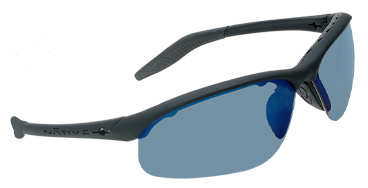With the holiday shopping season right around the corner, it’s time to put together your Christmas list. Whether buying for the skier or snowboarder in your life, or even shopping for yourself, we’ve put together some of the best gift ideas for your snow sports wish list in this, our annual FTO Holiday Ski & Snowboard Gift Guide.
Our Gift Guide has grown in 2006 to the point that we’ve had to split it into two parts. This is Part II, devoted to ski and snowboard accessories. Part I focuses on ski and snowboard apparel.
Within this article we’ll examine:
- Ski and snowboard packs
- Snow shovels
- Ski goggles and sunglasses
- Ski and snowboard boot dryers
- Electronic gadgets and gizmos
Pack to the Future
We tested new snow sports packs from new fewer than three manufacturers this year. What they all have in common is approximate size (all are suited to lift-served or backcountry day skiing), the ability to carry skis (or in the case of one pack, a snowboard instead), and hydration-system compatibility. Beyond their similarities, however, we’ll examine each in detail.
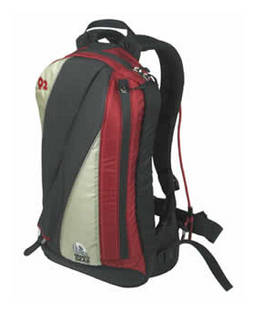
The Granite Gear Q2 employs a revolutionary ski carry system. |
Most impressive to us this year in terms of innovation is the ski carry system employed by Granite Gear in its new Q2 ski pack ($145). The name “Q2” refers to “quick quiver,” whereby this ingenious attachment system allows the wearer to stow or remove a pair of skis without even removing the 1200 cu. in. (19.6-liter) pack! A tail loop is shock-corded to the bottom left of the pack, so the wearer reaches behind with his or her left hand to pull down and expose the loop. The skis are then inserted into this loop as if sheathing a sword. The wearer’s right hand then reaches down to the pack’s right hip belt to disconnect a metal clip connected to the right shoulder strap via another shock cord, which is wrapped around the shovels of the skis and reconnected to the shoulder strap. Voila! The skis are packed.
To remove the skis, the wearer simply unclips the shovels and pulls the skis from the tail loop, which self-retracts back into the pack. Clip the shovel strap back to the hip belt, and it’s time to head downhill.
It sounds complicated, and the first few tries are admittedly tricky to accomplish. With a small bit of practice, however, the process becomes nearly effortless
to complete. The pack maintains a thin profile for riding chairlifts without removing it, and the stiffener, hip belt and shoulder straps are all thickly padded and comfortable for all-day wear. The front of the pack is heavily reinforced to resist abrasion from ski edges. The main compartment contains separate sleeves for snow rescue gear, and a triangular front pocket to separate mesh compartments for organization.
The manufacturer correctly notes that filling this triangular compartment helps to stabilize skis during transport. Weatherproof zippers are utilized in all exterior locations. It’s sized for a regular torso only, and tips the scales at 2 lb. 8 oz.
The downsides? We would have preferred a hydration tube sleeve within the shoulder strap, and multi-sport snow sliders beware, this pack won’t carry a snowboard. The main compartment zipper only traverses the top of the pack and runs down one side — we would have liked to see it descend both sides of the pack. But these are minor quibbles, far outshadowed by the Q2’s revolutionary ski carry system.
www.granitegear.com
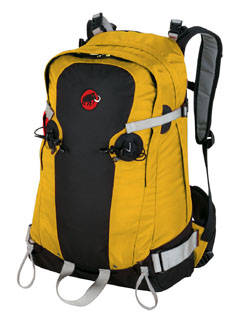
The Mammut Serac 30 |
The Swiss company Mammut supplied us with a test sample of its Serac 30-liter (1830 cu. in.) snowsports pack ($149), capable of carrying skis in either an A-frame configuration, or vertically via a tuck-away tail loop and shovel strap. All areas subject to abrasion by ski edges are heavily reinforced in either carry configuration. An open main compartment has plenty of room for a jacket, fleece and other essentials, while a separate compartment on the front provides separate access for snow rescue gear, with hook-and-loop straps to secure an avalanche probe and shovel handle. A removable helmet carrier clips to the front of the pack, useful for warm climbs but troublesome unless the skis are carried in an A-frame manner. The hydration tube is insulated within the left shoulder strap to prevent icing. Exterior zippers are weatherproofed via storm flaps. A pair of ice axe loops complete the feature set.
When fully loaded, the Serac 30 had the thickest profile of any pack tested, and at 3 lbs. 3 oz., this was the heaviest pack reviewed, but then again it had the largest capacity of any pack we tested. It’s for this reason that the Serac 30 is perhaps best suited to back country exploits rather than lift-served sidecountry.
We would have preferred to have more padding in the hip belt and shoulder straps, and more support in the back stiffener. And like the Granite Gear Q2, the Serac 30 will only carry skis, not a snowboard. These minor drawbacks, however, were hardly enough to reverse our recommendation of the Mammut Serac 30 for any hardcore backcountry ski enthusiast.
The Serac 30 comes in your choice of red, carbon, dive (a bright blue) or lemongrass (a burnt yellow).
www.mammut.ch

The Mountainsmith Off-Piste 25 |
Finally, we spent a day with the Off-Piste 25 from Mountainsmith, which at 28.7 liters (1750 cu. in.) is sized between the aforementioned packs from Granite Gear and Mammut. Another marvel of day pack engineering, the back stiffener on the Off-Piste 25 doubles as both a snowboard cross-carry system and a fold-down padded backcountry seat.
Construction is of a 420d Velocity nylon fabric. Skis are carried via either a diagonal or A-frame configuration via straps that conveniently tuck out of the way into hook-and-loop secured pockets when not in use. Snowshoes may be carried vertically, and snowboards either vertically or horizontally, making this the only true multi-glisse pack that we reviewed. The large main gear compartment includes two mesh pockets for organization, while the front pocket is separated for quick access to snow rescue gear. A traditional daisy chain down the center of the pack’s front provides numerous gear attachment points. Pockets on each hip belt, one solid and one mesh, provide quick access to a camera or other
frequently-used essentials. Weather protection for exterior zippers is provided via storm flaps, and the hydration tube is insulated within the left shoulder strap.
The Off-Piste 25’s hip belt isn’t thickly padded, but its oversized width distributes weight and pressure effectively. Conveniently accessed via a top pocket without removing the pack is a felt-lined goggle pocket which is also ported for headphone cables. This pack weighs in at 2 lb. 4 oz.
Our beefs? The hydration tube is tricky to feed from the reservoir into the shoulder strap, the ski carry straps lack reinforcement against edge abrasion, and the side compression straps limit access to the main compartment. But again, these are minor quibbles that don’t warrant withholding our recommendation.
The Mountainsmith Off-Piste 25 comes in black, blue or red.
www.mountainsmith.com
Scoop Instead of Shovel

The SnowClaw Backcountry Snow Shovel |
We checked out the SnowClaw, an inexpensive and pack-sized alternative to the traditional avalanche shovel. Somewhat hesitant about its flexibility, we set off to see if it could be used effectively.
The SnowClaw is an approximately foot-wide piece of flexible high-impact copolymer with a pair of holes molded as handles that weighs a mere 6.7 oz. It achieves its rigidity as a user flexes both hands inward to bend the SnowClaw into a U shape to scoop snow and avalanche debris. We found the dragging-and-scooping motion moves more snow more quickly and with less fatigue than a traditional shoveling motion. And to our surprise, we found that we could move reasonably firm snow without difficulty.
Lacking a handle, the SnowClaw packs easily and conveniently. A set of three holes molded along each side pairs with straps to form a snow anchor or a backcountry extremity splint as well. And it’s priced well below traditional avalanche shovels
at $14.99. An aluminum version is available for $24.99.
www.snowclaw.com
See and Ski
Whether to wear goggles or sunglasses while skiing or snowboarding is a matter of personal preference as well as weather conditions. It’s essential, though, to protect your eyes one way or the other against harmful UV light reflecting off high-elevation snow as well as against blowing snow and other particles.
We therefore tested and reviewed both goggles and sunglasses this year.

The Optic Nerve 4fifty4 ski goggle |
Optic Nerve, primarily known for its sunglasses, produces only a single true goggle model, the 4fifty4 ($54). A high definition vermillion/rose lens with a slight mirror finish provides 100% protection against harmful UV rays, and from our testing excellent terrain definition in moderate and low light conditions. The hinged articulating strap attachments mold well with most helmet designs.
We found the gloss black frame to be simple, yet aesthetic, not gaudy like many high-end ski goggles on the market. We were able to induce fog in only the most extreme conditions during our testing (heavy perspiration and heavy breathing while bending over), thanks to the dual thermal polycarbonate lens and passive venting that quickly dissipated any fogging that we were able to produce. Optical clarity was exceptional for a goggle, and at $54 it’s priced right. An alternate clear lens for night skiing and a storage pouch are both included in the package.
www.nerveusa.com

The Haber Vision Prima goggle |
Haber Vision is a company created when Steve Haber sold his interests in Bollé after developing that better-known brand. We tested two of Haber Vision’s goggles, the brand-new Prima ($130) and the Riva ($110). Both feature a double polarized orange lens with a blue rainbow mirror coating that yields perfect optical clarity while the polarization minimizes glare from sun reflecting on snow, enhancing terrain definition in all conditions in our testing. We were unable to get either goggle to fog at all during our testing. The Prima sports a slightly wider profile and greater volume for fit over eyeglasses. Both goggles feature an articulated hinge to enhance fit while wearing a helmet. The Prima comes in a black glossy frame, while the Riva comes in a silver frame. Our testers with larger facial features needed to trim the facial foam a bit to eliminate compression around the nostrils. Both goggles come packaged with a microfiber storage pouch for protection.
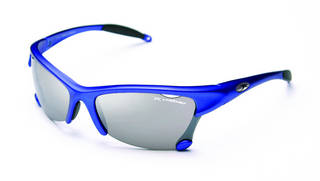
The Haber Vision Velocity sunglass
The Hardtop XP from Native Eyewear |
We also tested a polarized sunglass from Haber Vision, the Velocity ($155) which sports a funky frame style with an arm that reaches down each side to secure the polarized, high-impact lens from below as well as above. For optical clarity, this was our favorite of all of the sunglasses tested. Terrain definition on snow was exceptional. Frames are available in silver or blue with pumice or Haber rose flash-mirrored lenses.
www.HaberVision.com
For versatility, we loved the new Hardtop XP ($135), a polarized brown-lensed sunglass from Native Eyewear that also includes orange crystal, yellow crystal, and clear crystal non-polarized interchangeable lenses for 100% UV protection under varying light conditions. The polarized lens provided excellent glare-free definition on snow during bright, sunny days, while we preferred the orange crystal during times of bright overcast and the yellow crystal for dark and cloudy days. Frame colors are available in asphalt, iron, charcoal, or Tiger’s Eye, and polarized lens options come in gray, green, brown, blue reflex and bronze reflex. Each Hardtop XP comes packaged with a substantial pouch that holds an included extra set of temples with a built-in strap and a special tool
to swap the temple styles as well as the different included lenses in separate pockets for maximum versatility with portability.
www.nativeeyewear.com

The Envy from Tifosi Optics |
That same lens interchangeability and 100% UV protection comes at a much lower price point in the Envy ($59.95) from Tifosi Optics. Despite its lower price, the found the mirrored smoke lens to offer very good optical clarity, and the Envy is packaged with interchangeable red and clear lenses for varying light conditions. It also includes a hard case and a soft microfiber storage bag/cleaning cloth. Frames are available in seven color options, including silver, black, tortoise,
yellow, orange and blue.
For those who don’t need lens interchangeability, Tifosi also offers the Forza in a single-lens sunglass at an even more affordable price ($29.95). We found its qualities to be nearly identical to those of the Envy, save for the interchangeability. For $59.95, Tifosi also sells the Forza with a Fototec lens that adapts to changing light conditions.
www.tifosioptics.com
Happiness Equals Dry Boots
Dry ski boots are essential to maximize comfort and minimize mold, rot, foul odors, and bacteria and fungal spores. Reviews of dryers for ski and snowboard boots generally focus on fan- or heat-based products. We’ve strayed from the norm this year to try a set of chemical dryers from Dryzone.

Dryzone dries ski boot inner liners overnight without electricity. |
Dryzone boot dryers (£19.95, about US $38) operate on the same principle as the tiny silica gel packs inserted for shipping in electronics products and other products that need to remain dry. Packed inside a zip-lock storage bag are a pair of canvas tubes filled with a thousands of hygroscopic crystals — they’re as simple as that. Just insert the Dryzone tubes into the foot region of ski boots and leave them overnight as they absorb and lock the moisture in the Dryzone crystals. In the morning, after eight hours, we found our ski boots to be dry as a whistle.
Common to all types of boot dryers, you don’t need to remove your inner boots from their shells to thoroughly dry them out, but Dryzone has numerous advantages over heat- or fan-based products. Inner boot odor isn’t distributed throughout a cramped hotel room. There’s no noise to keep your roommates awake. No electrical power source is required to dry your boots.
Dryzone boot dryers are recharged by microwaving them at medium power for four minutes, or placing them on a radiator or ventilation duct for 15 to 30 minutes. They may of course be used on any type of footwear, not just ski boots, so they have useful application for hiking boots, hockey skates, work boots, or regular shoes, as well as hats, gloves, or other damp accessories.
www.dampire.com
The Electronic Age
In this era of gadgets and gizmos, it’s only fitting that we look at a few electronic options to please your skier and snowboarder at the holidays.
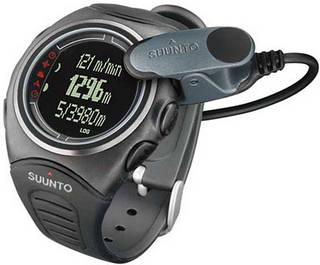
The Suunto S6 wrist-top |
At $299 it’s on the pricey side, but the Suunto S6 earns its description as a wrist-top computer. Suunto is widely regarded as quality and function leader among altitude sports watches and the S6 didn’t disappoint. In addition to the functions widely available across this product category, including altimeter, barometer, thermometer, digital compass, clock, alarm, and chronograph functions, the S6 stands apart thanks to its ability to record data for later transmission to a PC to analyze your uphill and downhill performance. Plug the cable from the watch into your computer’s serial port (or USB port via an optional adaptor), and with the supplied software you have access to a log book to chronicle your ski season. The software allows you to graph and chart your ski day in an attractive and informative graphical format. Other functions unique to the S6 include vertical speed and measurement of slope angle by sighting across the watch’s crystal. By combining slope angle and vertical descent measurements, the S6 can even
estimate the ground speed at which you’re skiing!
We found the S6 functions easy to use once we spent some time playing with the watch with the user’s manual nearby. Only a short set of commands needs to be remembered to start and stop the watch’s data recording for each ski day. Memory capacity is adequate to wear the watch throughout a typical ski vacation, only transferring the data to your computer upon your return home. The S6 clearly stands head-and-shoulders above its competition and earns its price tag.
www.suunto.com
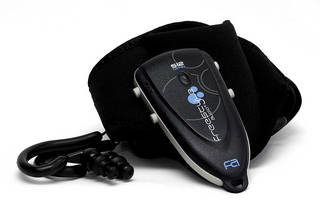
The Freestyle Audio DMP MP3 player |
Most personal audio players can be notoriously cranky in the cold, damp environment customarily encountered while skiing or riding, so why risk carrying your iPod on the slopes? Enter the Freestyle Audio DMP (Digital Music Player). This tiny MP3 player is waterproof, and completely submergible up to 10 feet, even with the headphone plug removed from the jack. It’s thus compatible not only with skiing and snowboarding, but also with swimming, surfing, wakeboarding, sailboarding, and all other water-borne activities. Both Mac and PC users can transfer digital music to the unit’s flash memory, which is available in either 256 MB ($139.95), 512 MB ($169.95) and 1 GB ($199.95) sizes. Each unit comes packaged with waterproof ear buds, a USB transfer/charging cable, a neoprene arm band, and PC playlist software on CD-ROM.
Battery charging takes approximately 150 minutes via USB, and yields approximately 35 hours of playtime with the included earbuds via an internal Li-Ion battery. The unit weighs a mere 35 grams (1.25 oz.) including the battery. Playback is simplistic – available controls are only play, stop, next track, previous track, and volume. The unit only plays MP3-format music files, so songs stored in other formats need to be converted to MP3 prior to transfer to the device. We found the lack of direct music selection and a display somewhat annoying, but we understand that including an LCD display would make the unit more susceptible to water intrusion and thus defeat its primary purpose.
www.freestyleaudio.com
Pardon the pun, but what in the world would a skier or snowboarder do with a shortwave radio? Whether traveling to ski in foreign lands where English-language broadcasts are non-existent, or venturing into the wilds or the backcountry where local radio broadcasts are few and far between, a world-band radio can
keep skiers in touch with the news and events from home while traveling. Tune into not only AM and FM frequencies, but also the Voice of America, Armed Forces Radio, the BBC, the Canadian Broadcasting Co., and other English-language broadcasts from radio stations that transmit their signals clear around the world. Put the radio into a pocket-sized package, and couple it with an alarm clock and sleep timer, and you have an all-in-one travel information and entertainment device.
Eton produces world-band radios under its own name, and also serves as the sole North American licensee for the Grundig brand of world receiver. We tested three models from the company. All offer pocket-sized portability, and differ primarily in feature sets and retail price.

The Eton E100 world band receiver |
Our favorite by far was the Eton E100 ($100), a micro-sized marvel with a feature lineup customarily found only on larger and more expensive world-band receivers, including digital direct-access tuning, 14 shortwave bands, 200 station presets, station scanning, an alarm clock including favorite station wake-up, a sleep timer, and more…all in a unit weighing only seven ounces and 5 inches wide by 3 inches high and 1.25 inches deep. Antenna gain is adjustable, as is audio tone, and a manual fine-tuning control is also provided. Frequency drift was non-existent. The unit feels solid in hand, such that the build quality is palpable. FM is available in stereo through the included earbud headphones, and the unit
comes packaged with a leatherette case and even batteries.
A less expensive option that still possesses digital frequency readout, albeit with analog tuning, is the G1000A from Grundig ($50). In addition to AM, FM (in stereo with the enclosed earbud headphones) and eight shortwave bands, the G1000A also includes clock, alarm and sleep timer functions. We found frequency drift to be noticeable on the digital display. Its physical dimensions are nearly
the same as the E100.
At $30, the Grundig Mini 100PE was the least-expensive model we tested, and quite possibly one of the least-expensive world band receivers on the market. The Mini 100PE uses slide-rule analog tuning to deliver AM, FM (in stereo with the enclosed earbud headphones) and six shortwave bands. It weighs only 4.5 ounces and includes a soft protective case, belt clip, and two AA batteries.
www.etoncorp.com
Our Methods
Our objective testing and review process allows us to provide insight into the best of the best ski and snowboard apparel and accessories. These are not paid product placements – rather, they’re products that our own staff have tested, used and reviewed. We highlight only the top products from our testing and review process, so we guarantee that any selection listed above will be a hit with the skier or snowboarder in your life.

